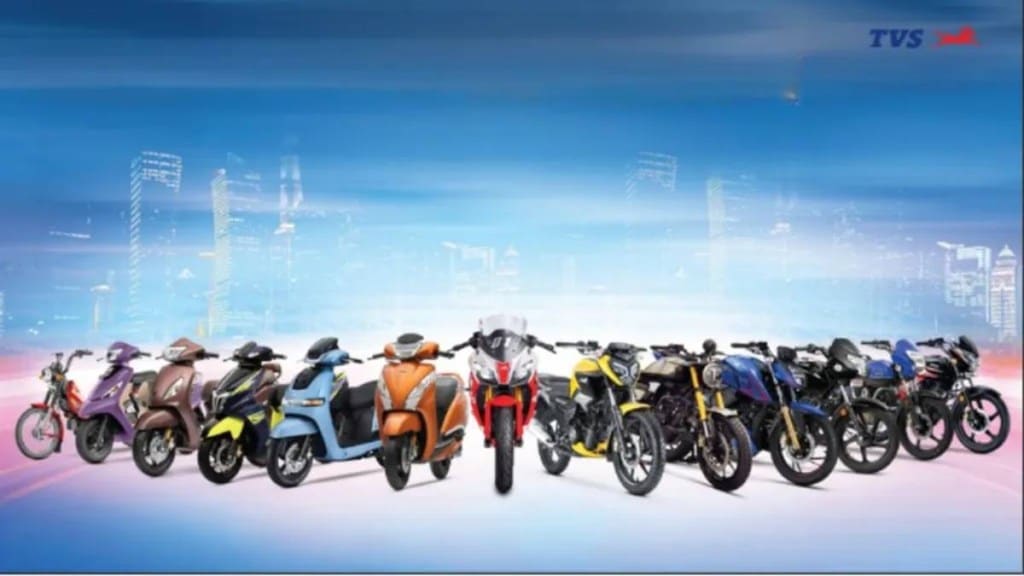TVS Motor’s standalone net profit rose 35% year-on-year to Rs 778.59 crore in the first quarter of FY26, driven by record sales volumes in both domestic and export markets. Revenue from operations grew 20% year-on-year (y-o-y) to Rs 10,081 crore, crossing the Rs 10,000-crore mark for the first time. Both revenue and profit exceeded Bloomberg analyst estimates of Rs 9,973 crore and Rs 760 crore, respectively.
Operating earnings before interest, tax, depreciation, and amortisation (Ebitda) rose 32% y-o-y to Rs 1,263 crore — its highest-ever quarterly figure – beating Bloomberg’s estimate of Rs 1,169 crore. Ebitda margin improved by 100 basis points to 12.5% during the quarter.
TVS reported its highest ever quarterly sales
The Chennai-based two- and three-wheeler manufacturer reported its highest-ever quarterly sales in the first quarter of FY26, with total volumes, including exports, rising 17% y-o-y to over 1.27 million units. Motorcycle sales grew 21% to 621,000 units, while scooter sales rose 19% to 499,000 units. However, moped sales declined 10% y-o-y to 112,000 units. Internal combustion engine (ICE) scooter and moped sales were higher in the previous quarter at 502,000 and 113,000 units, respectively.
KN Radhakrishnan, director and CEO, TVS Motor, statement on first quarter of FY26
KN Radhakrishnan, director and CEO, TVS Motor, attributed the softness in the ICE segment to seasonal factors. “In the ICE segment, this quarter the rural growth was only 3.3% while the average is 4%,” he said, adding that rural demand is expected to pick up in the current quarter with a pick-up in agriculture activities.
However, its electric scooter sales grew 35% y-o-y to 70,000 units, compared with 52,000 units in Q1FY25. The company’s revenue from the EV segment stood at Rs 1,000 crore for the quarter. It also retained its lead in the electric two-wheeler (E2W) market for the fourth consecutive month, with a 22% share in July.
Three-wheeler sales rose 46% to 45,000 units in the June quarter, up from 31,000 units a year ago. Electric scooter sales grew 35% y-o-y to 70,000 units, compared with 52,000 units in the year-ago period. The company’s revenue from the EV segment stood at Rs 1,000 crore for the quarter.
TVS Motor recently announced plans to launch four new models under the UK’s iconic Norton brand across the UK, India, and key European markets by the end of FY26. The first to be rolled out will be a flagship 1200cc four-cylinder superbike. “The success of any company depends on not just one product. We are looking at 3 products with 2 variants so there will be 6 Norton products,” Radhakrishnan said. The company will invest Rs 2,000 crore this financial year, including in Norton, towards product development, brand building, and marketing.
The board of TVS Motor approved a Rs 500-crore fundraise through the issuance of non-convertible debentures on a private placement basis. Chief financial officer K Gopala Desikan said, “It is to comply with the Sebi mandate which requires companies to raise at least 25% of their previous year’s borrowing from the capital market. It’s an enabling resolution but the actual amount will depend on market conditions and requirements.” Shares of TVS Motor closed 0.55% higher at Rs 2,809 on the NSE on Thursday.
TVS Motor, the country’s largest electric two-wheeler (E2W) seller, is adopting multiple strategies to address the shortage of rare earth materials, including sourcing from countries other than China and exploring new technologies. “We are managing our daily production for now, but we are actively working on alternatives, which will take some lead time,” said KN Radhakrishnan, Director and CEO. In the short term, he said, the company has sufficient inventory to support ongoing production.
“We have resized locally available higher-sized magnets and are exploring short-term alternatives. In the medium-to-long term, we are working on magnetry technology and also looking at sourcing from other countries and definitely looking to partner with some of them in India,” he said, adding, “We need to build a more resilient company—and country—when it comes to magnet supply.”
